Movie Review
 |
 |
 |
 |
 |
 |
 |
Problems with Disney's Coco - Part 1
Coco: Paganizing Día de los Muertos
With Halloween and Día de los Muertos fast approaching, we considered it expedient to analyze Disney Pixar’s 2017 animated film Coco. This film presents to its audience a marvelous picture of Día de los Muertos in Mexico, but completely stripped of Catholicity, reduced entirely to pagan indigenous beliefs.
How should Catholics respond to the paganization of Día de los Muertos?
Plot summary
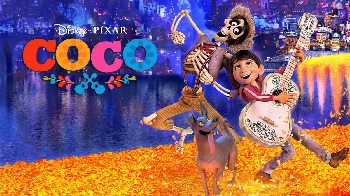
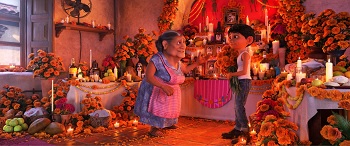 Wrapped in a colorful and lively presentation of Mexico and a message about the importance of family, we follow the story of Miguel, a boy with a passion for music whose
family of shoemakers has a strong anti-music streak. Miguel’s great-great grandparents were musicians, but tempted to a life of fame without the burden of family, the man left his wife Imelda and daughter Coco in order to become a great musician. His infuriated wife turned away from all music and imposed upon her future generations that they should be shoemakers and abhor music.
Wrapped in a colorful and lively presentation of Mexico and a message about the importance of family, we follow the story of Miguel, a boy with a passion for music whose
family of shoemakers has a strong anti-music streak. Miguel’s great-great grandparents were musicians, but tempted to a life of fame without the burden of family, the man left his wife Imelda and daughter Coco in order to become a great musician. His infuriated wife turned away from all music and imposed upon her future generations that they should be shoemakers and abhor music.
Much later, her great-great grandson Miguel, who wanted to be a musician despite the family prohibition to pursue music, was determined to break with his family to "follow his dream."
On the night of Dia de los Muertos, which, in this world created by Disney, has nothing to do with praying for the dead, Miguel had planned to shine in a talent show; but his abuela had just destroyed his guitar that very day. Under the impression that the “greatest musician of all time,” Ernesto de la Cruz, was his ancestor, Miguel snuck into his mausoleum and stole his guitar. When he started to play it, he and his dog Dante were both transported into the world of the dead.
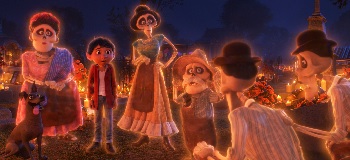 The world of the dead was filled with skeleton-people, the ancestors of the currently-living, as well as “spirit creatures,” which in this world are the psychedelic alebrijes. This after-world is not too different from the modern-day land of the living – there is no justice, no punishment for the bad or reward for the good; there are immoral customs, and the famous and wealthy continue their revelries. And there is absolutely no mention of God.
The world of the dead was filled with skeleton-people, the ancestors of the currently-living, as well as “spirit creatures,” which in this world are the psychedelic alebrijes. This after-world is not too different from the modern-day land of the living – there is no justice, no punishment for the bad or reward for the good; there are immoral customs, and the famous and wealthy continue their revelries. And there is absolutely no mention of God.
In this world, on the night of Dia de los Muertos, the deceased "skeletons" whose families set out ofrendas for them – altars with photos, food, candles, marigolds – were permitted to cross into the world of the living to visit and see their descendants.
Miguel discovers a depressing “reality,” that those inhabitants of the land of the dead whose families forget them entirely will forever disappear in what they call “the final death” or nothingness: A destiny quite different than what Catholic doctrine teaches us.
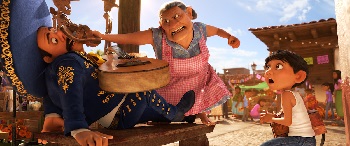 Then Miguel embarks on a journey to receive the blessing of one of his ancestors, the requirement for him to return home. His “Mama Imelda” was willing to give the blessing, but only on the condition that he would never be a musician. Miguel received the blessing and returned to the world of the living.
Then Miguel embarks on a journey to receive the blessing of one of his ancestors, the requirement for him to return home. His “Mama Imelda” was willing to give the blessing, but only on the condition that he would never be a musician. Miguel received the blessing and returned to the world of the living.
But he lied. Upon returning to the living, Miguel grabs De la Cruz’s guitar and strikes a chord, and straightaway returns to the world of the dead. After ongoing chase scenes with la policía, Miguel forces his way into meeting the extremely famous and nearly-inaccessible Ernesto de la Cruz in order to receive his blessing to return to the world of the living.
Sneaking into a fabulous "invited-only" night party, Miguel announces his presence by performing a De la Cruz song, and De la Cruz embraces him as the great-great grandson he did not know he had. As De la Cruz was about to give Miguel his blessing, Hector, the songwriter for the star, interrupts him. Hector had been helping Miguel along on his journey in the hopes that Miguel would put his photo on an ofrenda since he was close to disappearing as a forgotten ancestor.
During the confrontation Hector realizes De la Cruz poisoned him after learning he was returning home to his wife and daughter. Then De la Cruz stole Hector's guitar and songs, claiming they were his, which led him to fame and success.
We return to the land of the dead, which, as the readers sees, has all the vices and injustices of the land of the living. Certainly this is not Heaven. So, De la Cruz, to protect his reputation, steals the photo of Hector (so he will be forgotten) and throws both Miguel and Hector into a dungeon.
In the dungeon, they discover that Hector, not de la Cruz, is actually the great-great grandfather of Miguel and that Hector’s daughter and Miguel’s elderly “Mama Coco” is close to entirely having forgotten her father. The alebrije (spirit guide) of Mama Imelda rescues Miguel and Hector and brings them to the rest of the family; there they formulate a plan to retrieve the photo of Hector so Miguel can place it on the family ofrenda.
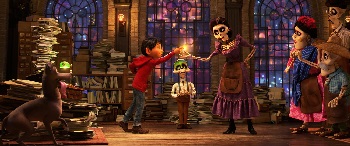 They sneak into De la Cruz’s Sunrise Spectacular concert and retrieve the photo of Hector, but unbeknownst to De la Cruz, a camera records him as he confronts Miguel and pushes him off a cliff. Miguel loses the photo in the great fall.
They sneak into De la Cruz’s Sunrise Spectacular concert and retrieve the photo of Hector, but unbeknownst to De la Cruz, a camera records him as he confronts Miguel and pushes him off a cliff. Miguel loses the photo in the great fall.
Meanwhile, De la Cruz receives his due dessert for this crime, since the attempted murder was on camera. He loses his popularity and faces a “second death” as he is crushed by a giant bell, the same as his earthly death.
But in that fall Miguel does not die. Mama Imelda’s alebrije saves himl, and she and Hector give Miguel their blessing so he can go home, even without Hector’s photo.
When Miguel returns to the world of the living, he runs home with De la Cruz’s guitar (which is really Hector's guitar) and in a moving scene, sings to Mama Coco the iconic song Hector wrote for her, Remember Me. Hearing it, Mama Coco remembers her Papa and gives Miguel a photo of him.
The following year, Miguel puts the photo of Hector on the family ofrenda and goes on to become a musician, and so all is well.
Problems with the movie
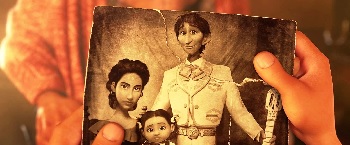
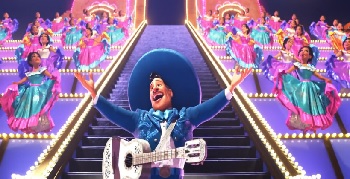 Overall, the animated movie Coco is well-done and moving, but it strips the Catholic tradition of Dia de los Muertos into a completely syncretist pagan festivity, reviving part of the Aztec and Mayan animism and completely omitting the dogmas of Heaven, Hell and Purgatory.
Overall, the animated movie Coco is well-done and moving, but it strips the Catholic tradition of Dia de los Muertos into a completely syncretist pagan festivity, reviving part of the Aztec and Mayan animism and completely omitting the dogmas of Heaven, Hell and Purgatory.
Although the filmmakers show a few crosses and images of Our Lady of Guadalupe, they are always presented in a nondescript way. So what we see is a secularized version of this feast, which completely leaves out the Catholic Faith in Día de los Muertos.
This secularization is exactly what Freemasonry always sought to establish in Catholic Mexico, which is one of the reasons why the Cristero War was fought. It would, therefore, be shameful for Mexicans to swallow the message of this film.
In parallel we noticed that most of the male figures in the movie are either weak or immoral. The family is presented as being led by the women, since the male head of the family abandoned his family for a career. Although there is some truth to the machismo that has pervaded some parts of Mexico, presenting a matriarchal ideal of Mexican family life is revolutionary and destructive.
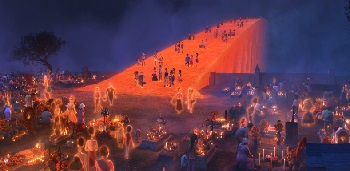
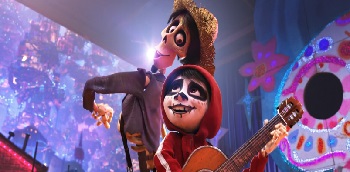 Further, Miguel never considers God, Our Lady or the Faith in his life decisions, basing them rather on personal whims and delusions of grandeur. There is no thought of religious or temporal duties. He has no problem lying, stealing and breaking God’s Commandments in order to get his way. This teaches youth that the end justifies the means, which is a false teaching contrary to Catholic Morals.
Further, Miguel never considers God, Our Lady or the Faith in his life decisions, basing them rather on personal whims and delusions of grandeur. There is no thought of religious or temporal duties. He has no problem lying, stealing and breaking God’s Commandments in order to get his way. This teaches youth that the end justifies the means, which is a false teaching contrary to Catholic Morals.
Further, it reinforces a bad modern tendency of today's youth, who have been led to believe that their our own will should be preferred over God’s will and over doing one’s duty according to one’s state in life.
The film also implies that it is not necessary to pray for those who have died, but only to remember them. It is only when a soul has been forgotten that it finally disappears into nothingness. This idea pays tribute to animism and is incompatible with the Faith. The Church teaches that every soul is eternal, and will live on forever either in Heaven (after being purified in Purgatory, which is necessary for most souls), or in Hell.
In the next article, we plan to delve into the Catholic origins of Día de los Muertos, and its modern paganization.
Continued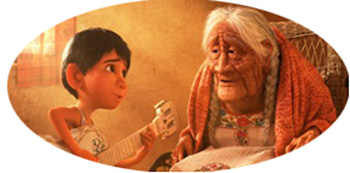

How should Catholics respond to the paganization of Día de los Muertos?
Plot summary

Coco, the Disney Pixar Film,
below, Miguel's family ofrenda

Much later, her great-great grandson Miguel, who wanted to be a musician despite the family prohibition to pursue music, was determined to break with his family to "follow his dream."
On the night of Dia de los Muertos, which, in this world created by Disney, has nothing to do with praying for the dead, Miguel had planned to shine in a talent show; but his abuela had just destroyed his guitar that very day. Under the impression that the “greatest musician of all time,” Ernesto de la Cruz, was his ancestor, Miguel snuck into his mausoleum and stole his guitar. When he started to play it, he and his dog Dante were both transported into the world of the dead.

Miguel meets his skeletal family
in the land of the dead
In this world, on the night of Dia de los Muertos, the deceased "skeletons" whose families set out ofrendas for them – altars with photos, food, candles, marigolds – were permitted to cross into the world of the living to visit and see their descendants.
Miguel discovers a depressing “reality,” that those inhabitants of the land of the dead whose families forget them entirely will forever disappear in what they call “the final death” or nothingness: A destiny quite different than what Catholic doctrine teaches us.

Miguel's grandmother, who shares the family hatred for music, smacks a mariachi musician
But he lied. Upon returning to the living, Miguel grabs De la Cruz’s guitar and strikes a chord, and straightaway returns to the world of the dead. After ongoing chase scenes with la policía, Miguel forces his way into meeting the extremely famous and nearly-inaccessible Ernesto de la Cruz in order to receive his blessing to return to the world of the living.
Sneaking into a fabulous "invited-only" night party, Miguel announces his presence by performing a De la Cruz song, and De la Cruz embraces him as the great-great grandson he did not know he had. As De la Cruz was about to give Miguel his blessing, Hector, the songwriter for the star, interrupts him. Hector had been helping Miguel along on his journey in the hopes that Miguel would put his photo on an ofrenda since he was close to disappearing as a forgotten ancestor.
During the confrontation Hector realizes De la Cruz poisoned him after learning he was returning home to his wife and daughter. Then De la Cruz stole Hector's guitar and songs, claiming they were his, which led him to fame and success.
We return to the land of the dead, which, as the readers sees, has all the vices and injustices of the land of the living. Certainly this is not Heaven. So, De la Cruz, to protect his reputation, steals the photo of Hector (so he will be forgotten) and throws both Miguel and Hector into a dungeon.
In the dungeon, they discover that Hector, not de la Cruz, is actually the great-great grandfather of Miguel and that Hector’s daughter and Miguel’s elderly “Mama Coco” is close to entirely having forgotten her father. The alebrije (spirit guide) of Mama Imelda rescues Miguel and Hector and brings them to the rest of the family; there they formulate a plan to retrieve the photo of Hector so Miguel can place it on the family ofrenda.

Mama Imelda gives Miguel her blessing after he promises to abandon music
Meanwhile, De la Cruz receives his due dessert for this crime, since the attempted murder was on camera. He loses his popularity and faces a “second death” as he is crushed by a giant bell, the same as his earthly death.
But in that fall Miguel does not die. Mama Imelda’s alebrije saves himl, and she and Hector give Miguel their blessing so he can go home, even without Hector’s photo.
When Miguel returns to the world of the living, he runs home with De la Cruz’s guitar (which is really Hector's guitar) and in a moving scene, sings to Mama Coco the iconic song Hector wrote for her, Remember Me. Hearing it, Mama Coco remembers her Papa and gives Miguel a photo of him.
The following year, Miguel puts the photo of Hector on the family ofrenda and goes on to become a musician, and so all is well.
Problems with the movie

The true husband of Mama Imelda is revealed;
below, the false ancestor Ernesto de la Cruz

Although the filmmakers show a few crosses and images of Our Lady of Guadalupe, they are always presented in a nondescript way. So what we see is a secularized version of this feast, which completely leaves out the Catholic Faith in Día de los Muertos.
This secularization is exactly what Freemasonry always sought to establish in Catholic Mexico, which is one of the reasons why the Cristero War was fought. It would, therefore, be shameful for Mexicans to swallow the message of this film.
In parallel we noticed that most of the male figures in the movie are either weak or immoral. The family is presented as being led by the women, since the male head of the family abandoned his family for a career. Although there is some truth to the machismo that has pervaded some parts of Mexico, presenting a matriarchal ideal of Mexican family life is revolutionary and destructive.

The bridge that connects the land of the dead to that of the living; below, Hector & Miguel dancing & singing in the land of the dead

Further, it reinforces a bad modern tendency of today's youth, who have been led to believe that their our own will should be preferred over God’s will and over doing one’s duty according to one’s state in life.
The film also implies that it is not necessary to pray for those who have died, but only to remember them. It is only when a soul has been forgotten that it finally disappears into nothingness. This idea pays tribute to animism and is incompatible with the Faith. The Church teaches that every soul is eternal, and will live on forever either in Heaven (after being purified in Purgatory, which is necessary for most souls), or in Hell.
In the next article, we plan to delve into the Catholic origins of Día de los Muertos, and its modern paganization.
Continued

A touching moment between Mama Coco
& Miguel ends the story

Posted October 28, 2024
______________________
______________________





